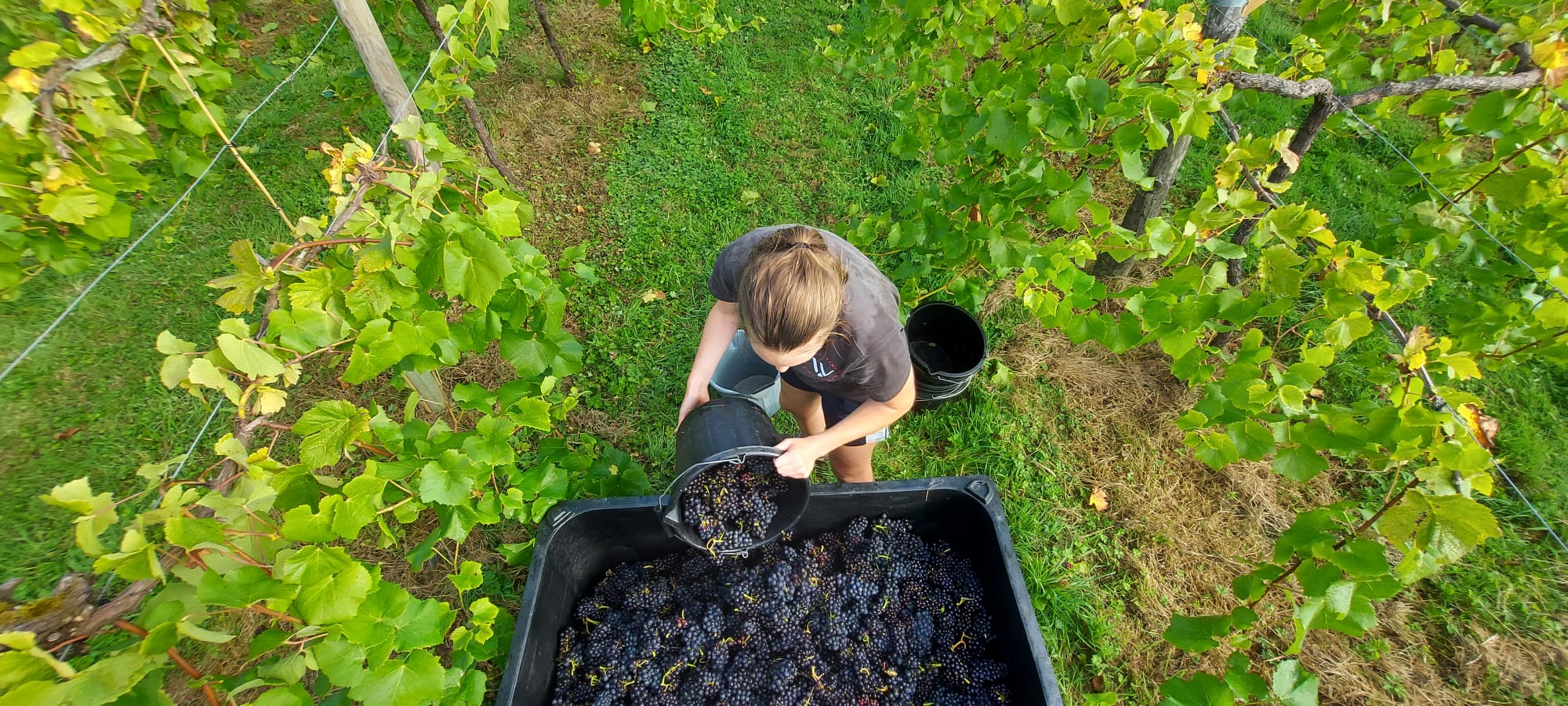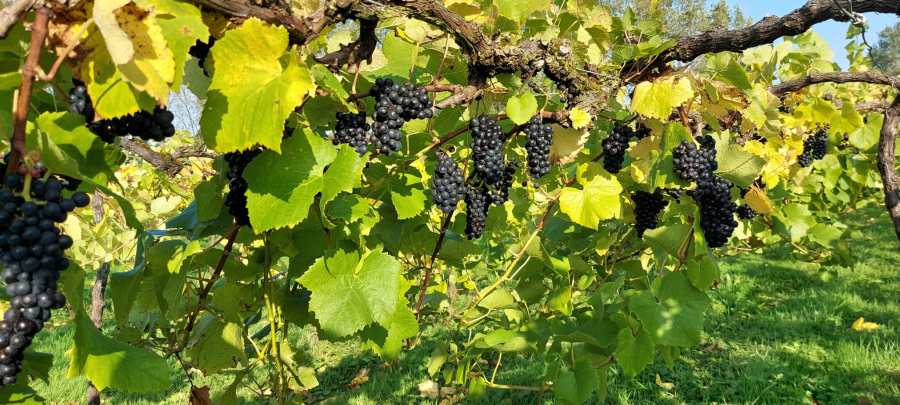Wraxall Vineyard in Somerset was established in 1974 and has successfully produced wine over many years, but now enters a new era. Vineyard hears about the visionary new owners exciting plans to modernise, renovate, and create a boutique vineyard producing high quality wines perfect for the tourism and foodscape scene of Somerset.
Wraxall Vineyard is believed to be Somerset’s oldest vineyard, and second largest, even though it is currently only 6 acres. The vineyard was first planted around 50 years ago, in the 70s, but rumour has it that there may have been vines on the site in Roman times. The vineyard was bought by David Bailey and Lexa Hunt in February 2021 as a long-term family investment with a view to developing and maximising the assets. “The vineyard had been well cared for but now needs a programme of modernisation and investment both in terms of planting to enhance the wine, development to facilitate wine tourism – and to ensure that the economics of the vineyard is on a firm footing,” explained David.
David and Lexa have both run and grown businesses previously, albeit in financial services and not wine. “I grew my previous business, with three partners, to 750 people across eight offices in the world and sold it in 2018. It was at that time that Lexa and I started to look for a house in the countryside and focussed on Somerset – subsequently finding Wraxall Lodge – a 200-year-old farmhouse that needed renovation and situated next to a vineyard. The vineyard had been up for sale for some time and given the vicinity to the house we subsequently decided to buy it in February 2021 – seeing opportunities to develop both the vineyard itself and the visitor facilities. It’s not a large vineyard, but new plantings in 2022 will increase the area to eight acres,” said David.
The history
“Wraxall Vineyard was originally planted with Seyval Blanc, Bacchus and Madeleine Angevine in the 1970s by the owners of Wraxall Lodge,” explained David. “In the late 1980’s, Raimund Herincx, one of the great Wagnerian opera singers of the 1960s and 1970s and his wife Astra Blair, took over the running of the vineyard. They added to the vines and planted a few Chardonnay – smuggled back from France by Raimund, hidden in some socks! Astra, a soprano and agent for opera singers, took her sales skills into the world of wine and Wraxall wine was served in First Class on British Rail GWR and at the Waldorf Hotel in London where it was a served with cream teas. When the Vineyard became too much for Raimund and Astra to manage they sold it and it fell into disrepair, before new owners in 2007 nurtured the vineyard back to life. Whilst there is local hearsay of the Romans growing vines at Wraxall, we have yet to find any evidence,” explained David.
Getting expert advice
“Once we started to contemplate the purchase of the vineyard, we needed help and guidance,” commented David. “Firstly, to decide whether it was a good site in terms of location and climate, and secondly to assess the state of the vines and their suitability for the modern wine industry – as most had been planted over 15 years ago – and some even longer. Thirdly, we needed a view on the opportunities, or otherwise, to grow and develop the vineyard and enhance the quality of the wines that it produces over the next 20-25 years. In effect we were looking for the sort of advice and due diligence you would receive from a surveyor when you purchase a house or a consultant when you buy a business,” David added.
“Our research led us to Alistair Nesbitt and the Vinescapes team,” added Lexa. “Alistair and the team visited the site and did some detailed analysis, covering not only the vines and the micro-climate but also the financial aspects of the vineyard, producing a detailed report and giving us the confidence to proceed with the purchase. Subsequently we have worked with Vinescapes on the development of the wine strategy and future plantings,” Lexa added.
With their strengths in business and financial services, rather than viticulture, David and Lexa used the vineyard management services from Veraison to guide them through their first season. “This has helped us to avoid some of the problems that I believe beset others during 2021, with us ultimately producing a high-quality crop in 2021,” commented David.
The View@Wraxall
David and Lexa identified the importance of ‘paying’ visitors and the overall vineyard experience in their early plans. “The current facilities weren’t amenable to expanding the visitor experience and so working with our local architects, Orme, we have developed, and are now in the process of building, ‘The View@Wraxall’ with a planned opening in May 2022.
The new visitor centre and tasting room with views of 25 miles across the Somerset levels to Dorset is designed to meld into its environment and be as unobtrusive as possible. The multi-purpose building will not only accommodate the tours and tastings, but is designed with flexibility in mind, will seat around 45 people, supported by full kitchen facilities, so it can be used for a range of events and occasions. “The building is dug into the hillside – you can walk onto the grass roof from the back of the building – but still provides amazing views through glass ‘walls’ on the south and west side of the building. The wine store is ‘dug into’ the hillside at the back – taking advantage of natural cooling and minimising energy requirements. Similarly, the ‘canopy’ over the terraces will be made up of solar panels providing much of the energy requirements for the building, with any supplementary heating being provided by an air source heat pump,” enthused David.
Wine and tourism
David and Lexa want Wraxall Vineyard to be known throughout Somerset and further afield for producing some of the best English wines and as a place for having the most fabulous experience. “Wraxall isn’t just about growing grapes – it cannot be. We have only six acres planted today and given the opportunity to expand, probably only a maximum of 15 acres. So, we need to focus on producing the best quality grapes, producing the best quality wine, and giving our visitors, the best possible experience. To achieve the wine style, we looked for a young and forward-thinking winemaker, and have selected Ben Smith at Itasca,” explained David.
Tourism is a critical element to the long-term financial viability of a vineyard such as Wraxall. “We are lucky enough to be situated in the tourist ‘Hot Spot’ of Somerset – 15 minutes from Bruton, 15 minutes from ‘The Newt’, 30 minutes from Frome and 45 mins from each of Bath and Bristol. Not only are we close to other attractions we also have access to a large local population,” commented Lexa.
“Without any marketing or PR, over 500 people have found their way to Wraxall in 2021, ranging from families, groups of friends and hen parties, local WI and Rotary Groups and of course many visitors who have been enjoying Somerset. The county has a reputation for fabulous food and drink, and it is lovely to be associated with such a successful industry which is growing by the day.
“Obviously, like all vineyards, our cellar door sales are important to us, but given our location overlooking the Somerset levels, we also have the opportunity to not only give our guests the experience of the vineyard and the wines that we create, but also the wide-open skies of the Somerset countryside,” Lexa added.
The old winery building at Wraxall, built originally in 1876, is now in the process of being turned into two holiday cottages. “We want our visitors to come and relax, rejuvenate and experience the vineyard – again hopefully to be completed around May 2022.
“The reality of English vineyards and English wine is that to make medium to small sized vineyards economically viable, supplemental income streams are a necessity. We estimate that the revenue from the holiday lets will go a long way to paying the wages of our two staff and removing some of the risk from the business of growing grapes,” commented David.
It’s very important to David and Lexa that the vineyard contributes to the local community. “We want the local community to think of it as ‘their’ vineyard,” said Lexa. “We have already created two jobs and there is likely to be more to follow as we expand what we do. We buy our picnics and food from local providers; we employ local architects and local builders to do all our work and we contribute to the local community in different ways. We have been very lucky in our careers, and we are keen to share and contribute back to our local community,” she added.
The vineyard
The six acre vineyard is currently a mix of Pinot noir, Pinot Précoce, Bacchus and Seyval. “We were pleased with 13 tonnes of good quality fruit in 2021,” commented David. “Unlike other vineyards we were lucky enough not to be frosted – and this site has a reputation for being frost free. With the good advice received we didn’t suffer from Botrytis, downy mildew, or SWD.”
“We worked with Vinescapes in early 2021 to develop a new planting and wine strategy for the vineyard going forward. As a result we will be removing the Seyval, within the next few weeks, and will be planting more Pinot Noir – and planting Pinot Meunier and Chardonnay in May 2022 – to give the vineyard a new mix for the next 25 years,” commented David.
The vineyard is managed on a day-to-day basis by James Brooking Clark and Stevie Poitier and guided by Veraison, a contract vineyard management service, led by Joel Jorgensen. “I started in February 2021, but I first encountered Wraxall many years ago when I helped the previous owners with the harvest,” explained James. “I recently acted as project manager for some construction work here, and now I’m pleased to have the opportunity to work in the vineyard, and to oversee the new plantings and ground preparation work,” added James.
“I started five years ago, with the previous owners,” commented Stevie, “first just to help out with the harvest, but increasingly to do more tasks. I really enjoy looking after the vines, I like being outside and love the seasonal nature of the work. The more I learn, the more I am interested in learning. My favourite task is pruning – it’s so satisfying – you can see the impact of the previous year’s pruning; you can learn from any mistakes and learn to project forward. I am also a musician, so sometimes I sing to the vines!” Smiled Stevie
It had been a challenging year for many vineyards, but Wraxall fared well and produced a clean crop with good yields. “A combination of things contributed to the lovely and abundant crop this year,” explained Joel. “For starters, the weather in Somerset was slightly kinder than in the East and we were lucky enough to find the weather windows necessary for well-timed crop protection and nutrition. James and Stevie worked really hard and we were able to time each operation perfectly. They spent countless hours micro-managing the canopy to ensure every shoot and every bunch had its own comfy place,” Joel added.
Together the team scout the vineyard diligently and proactively for nutritional deficiencies and diseases. “Apart from some minor magnesium deficiencies, we managed to keep the canopy spotless and vibrant green until natural senescence kicked in, weeks after harvest,” commented Joel. “Successful viticulture is all about timing; together we ensure each operation is tweaked towards the common goal of a balanced yield with perfect quality,” he added.
Unusually the vineyard is still trellised on the Geneva Double Curtain (GDC) system, and the new plantings are planned to be trained on GDC as well. “I think GDC is really well suited to this site because the cordon is just high enough to be above the ground-frost layer. The shape of the vines and incidental wider row spacing means that any compaction from tractor tyres is kept well away from the root system and the taller trunks make it safer to allow some weed growth without compromising air flow or worrying about competition,” explained Joel.
The low compaction and focus on soil health at Wraxall have resulted in a lively population of earthworms. “We were so pleased to hear the latest count of earthworms – an average of 26 in every single 20x20x20cm of soil, “exclaimed Stevie. “This indicates a healthy soil with a naturally aerated and permeable soil structure. There is virtually no bare soil on site and the diverse cover crop sequesters carbon and feeds the soil food web,” commented Joel. “And indeed, feeds our vines as well,” smiled James.
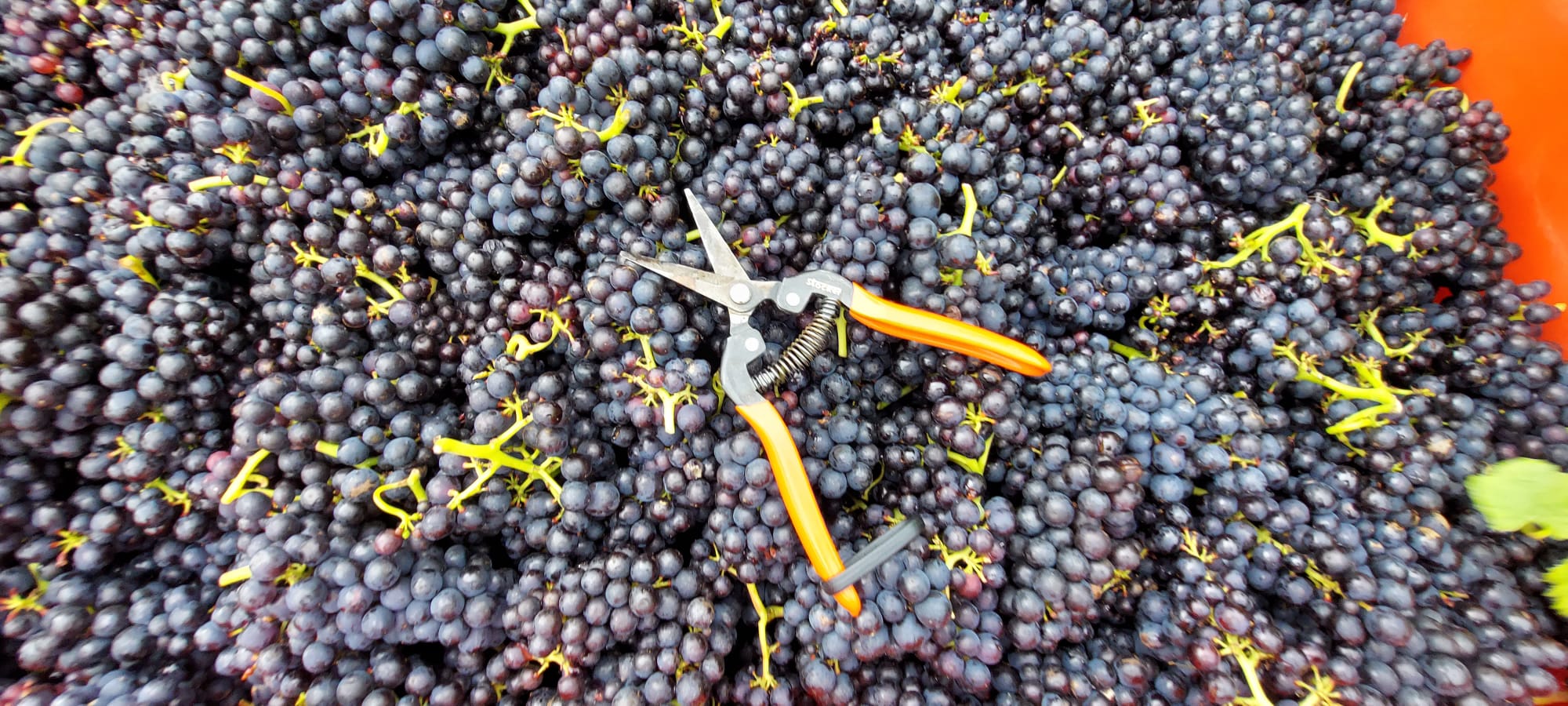
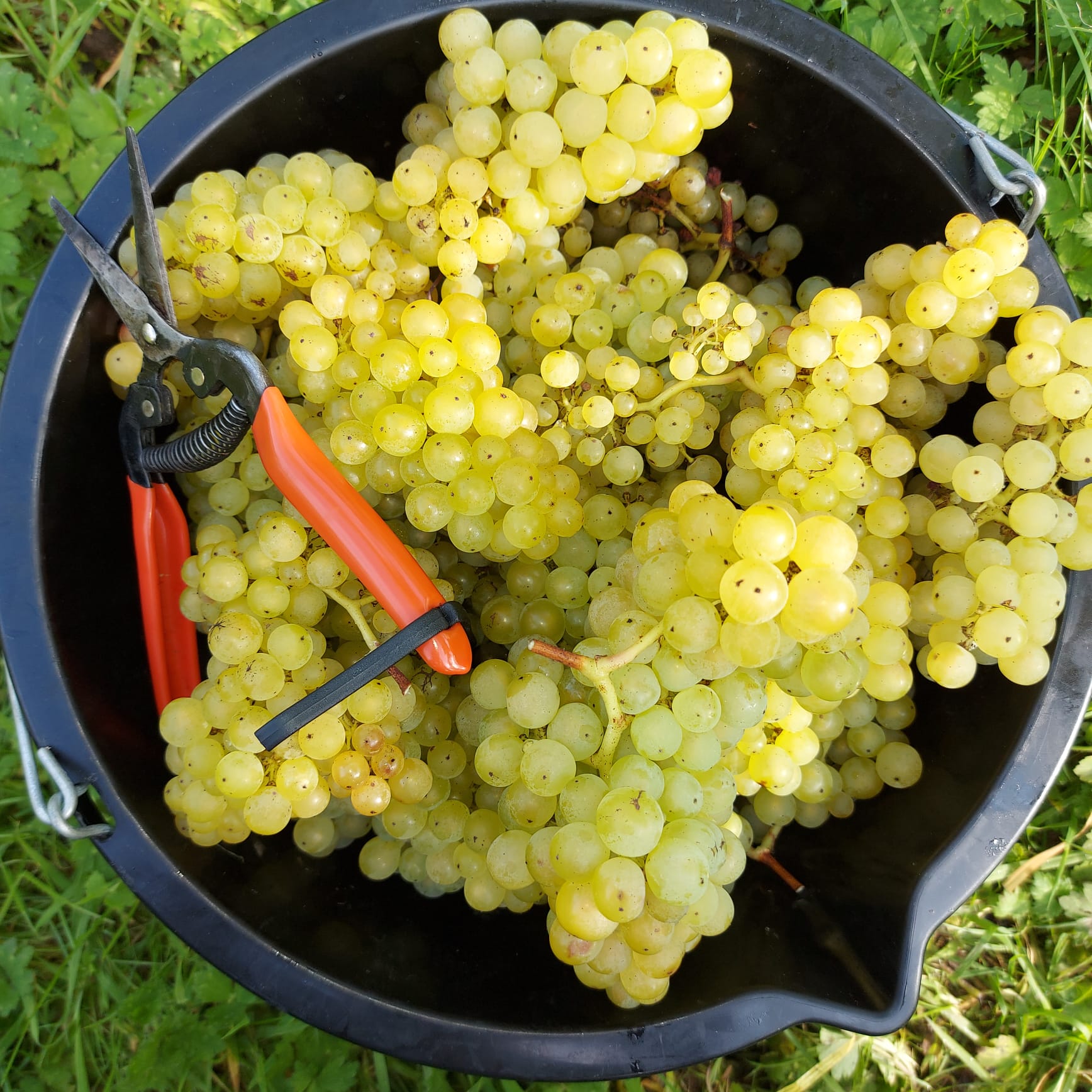
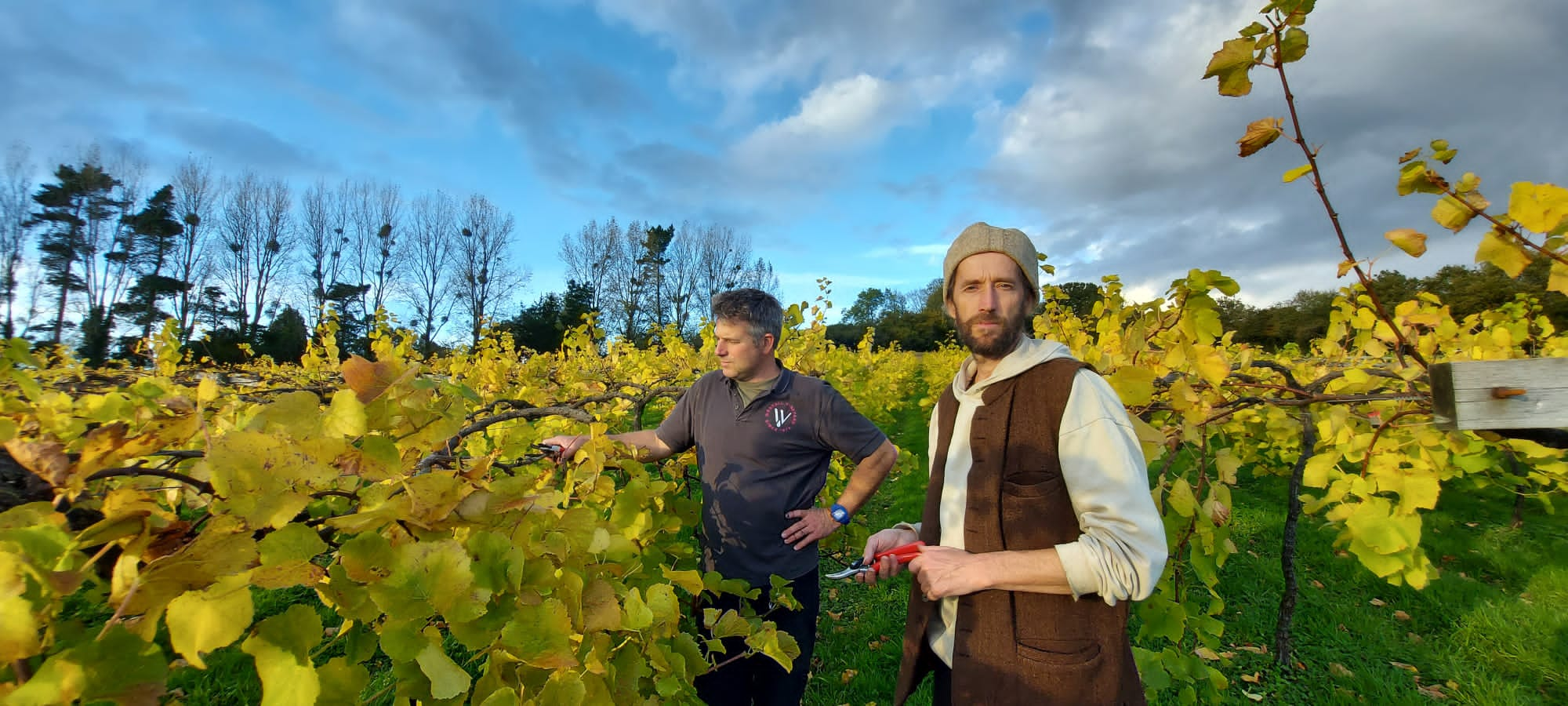
James Brooking Clark and Stevie Potier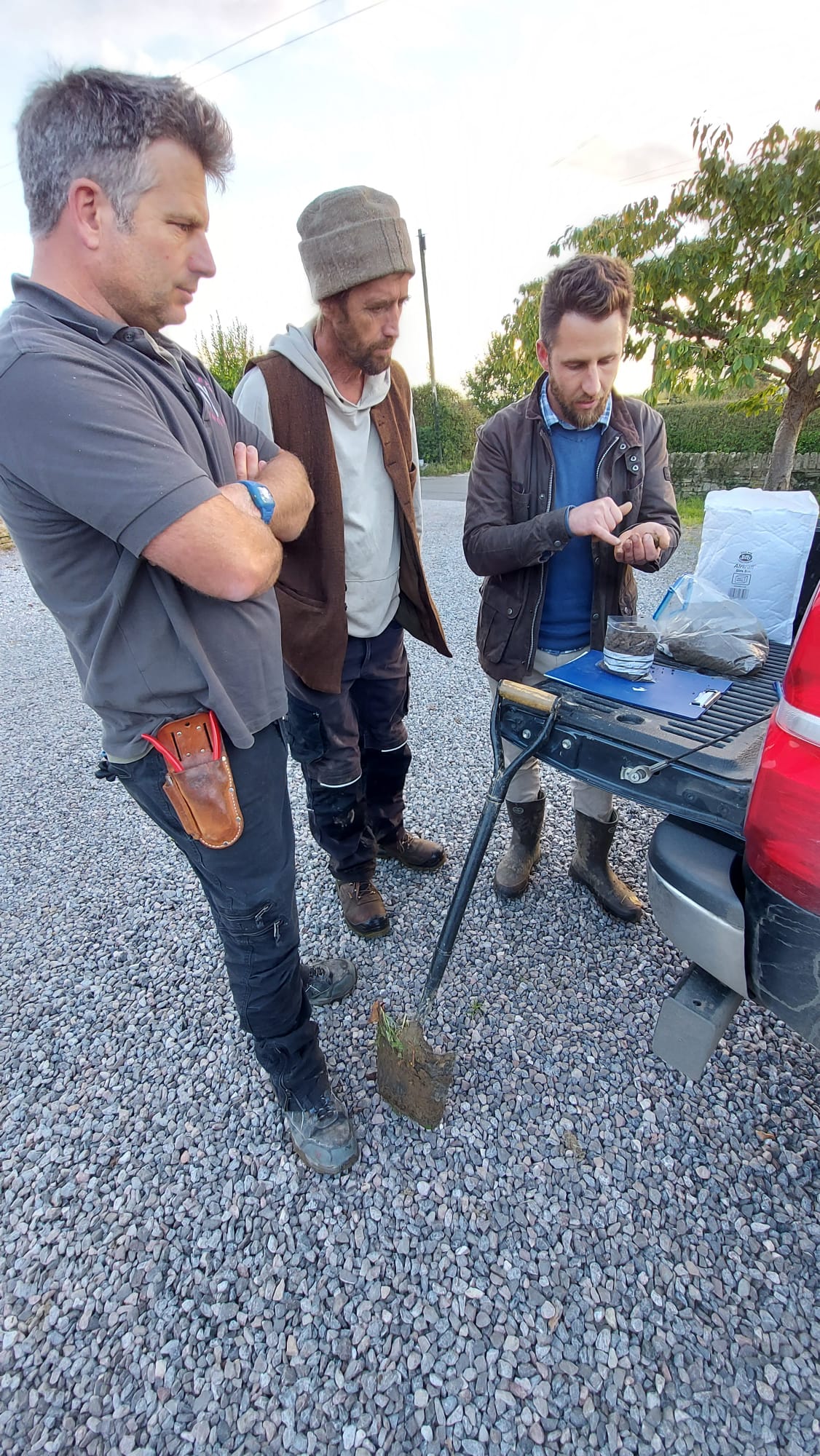
Stevie, James and Joel discussing the soil samples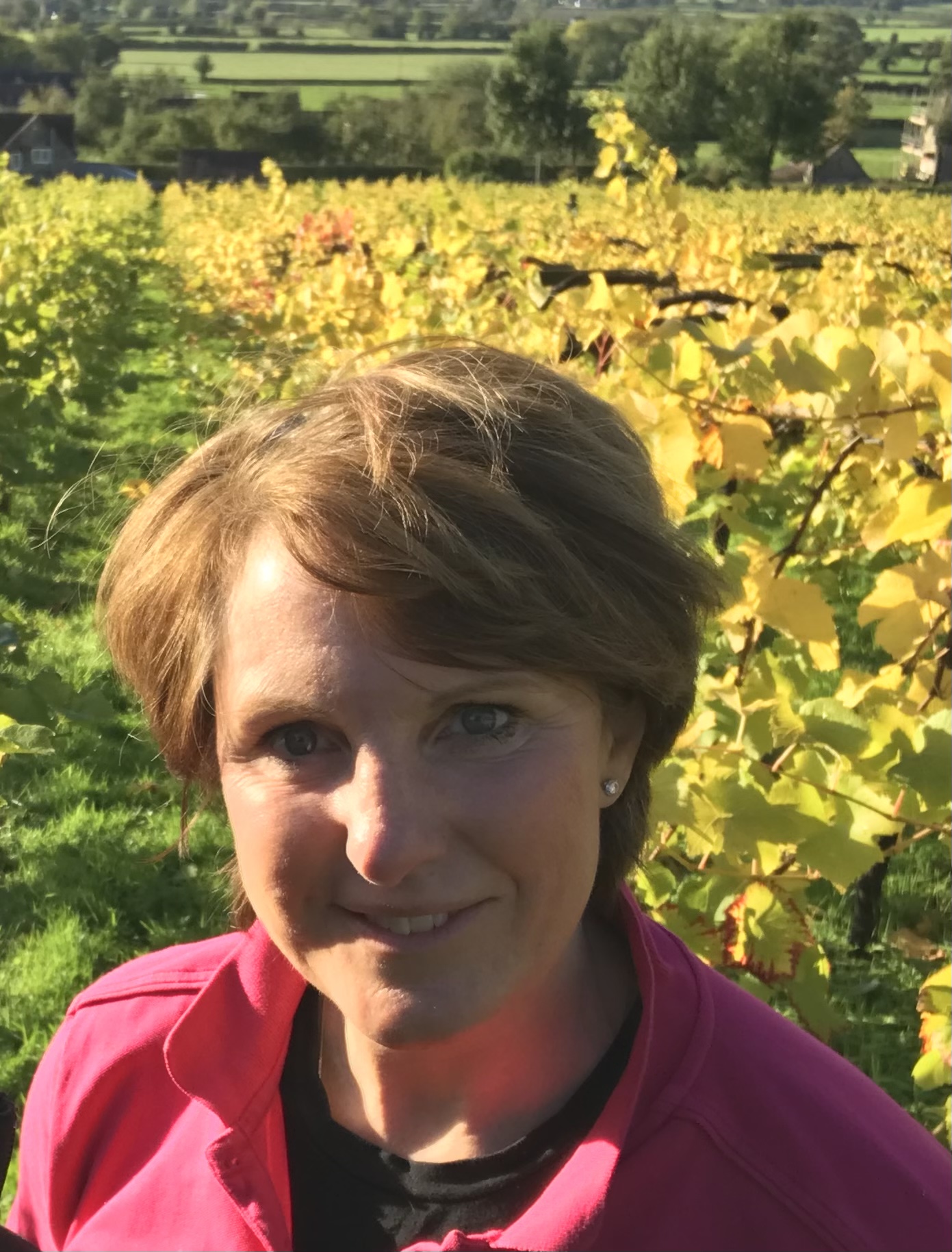
Lexa Hunt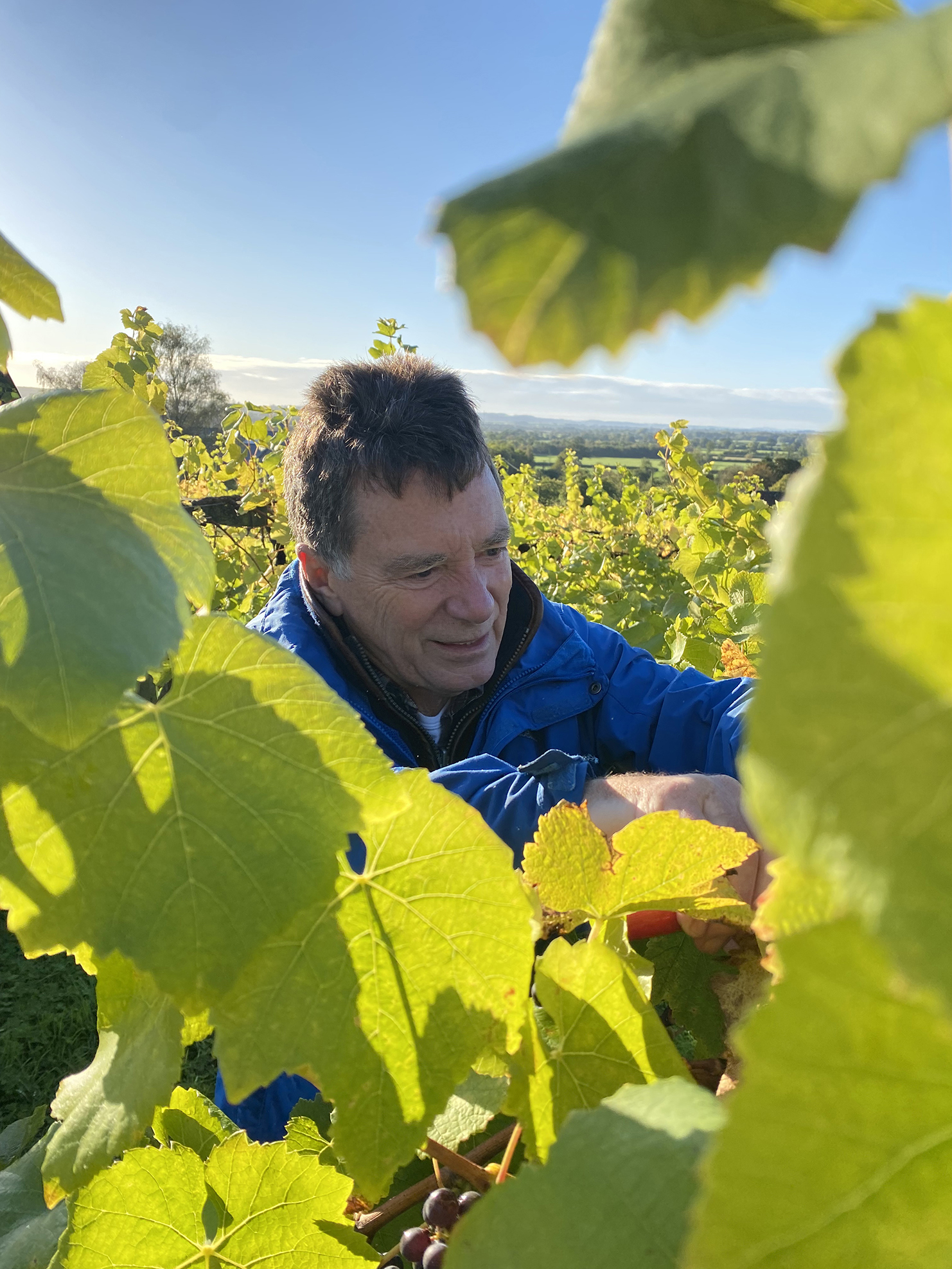
David Bailey